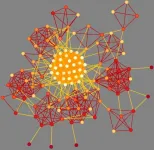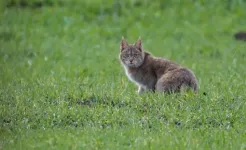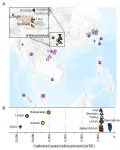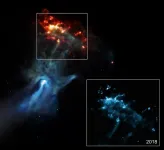(Press-News.org) Cosmic dawn, when stars formed for the first time, occurred 250 million to 350 million years after the beginning of the universe, according to a new study led by researchers at University College London (UCL) and the University of Cambridge.
The study, published in the Monthly Notices of the Royal Astronomical Society, suggests that the NASA James Webb Space Telescope (JWST), scheduled to launch in November, will be sensitive enough to observe the birth of galaxies directly.
The UK-led research team examined six of the most distant galaxies currently known, whose light has taken most of the universe's lifetime to reach us. They found that the distance of these galaxies away from Earth corresponded to a "look back" time of more than 13 billion years ago, when the universe was only 550 million years old.
Analysing images from the Hubble and Spitzer Space Telescopes, the researchers calculated the age of these galaxies as ranging from 200 to 300 million years, allowing an estimate of when their stars first formed.
Lead author Dr Nicolas Laporte (University of Cambridge), who started the project while at UCL, said: "Theorists speculate that the universe was a dark place for the first few hundred million years, before the first stars and galaxies formed.
"Witnessing the moment when the universe was first bathed in starlight is a major quest in astronomy.
"Our observations indicate that cosmic dawn occurred between 250 and 350 million years after the beginning of the universe, and, at the time of their formation, galaxies such as the ones we studied would have been sufficiently luminous to be seen with the James Webb Space Telescope."
The researchers analysed starlight from the galaxies as recorded by the Hubble and Spitzer Space Telescopes, examining a marker in their energy distribution indicative of the presence of atomic hydrogen* in their stellar atmospheres. This provides an estimate of the age of the stars they contain.
This hydrogen signature increases in strength as the stellar population ages but diminishes when the galaxy is older than a billion years. The age-dependence arises because the more massive stars that contribute to this signal burn their nuclear fuel more rapidly and therefore die first.
Co-author Dr Romain Meyer (UCL Physics & Astronomy and the Max Planck Institute for Astronomy in Heidelberg, Germany) said: "This age indicator is used to date stars in our own neighbourhood in the Milky Way but it can also be used to date extremely remote galaxies, seen at a very early period of the universe.
"Using this indicator we can infer that, even at these early times, our galaxies are between 200 and 300 million years old."
In analysing the data from Hubble and Spitzer, the researchers needed to estimate the "redshift" of each galaxy which indicates their cosmological distance and hence the look-back time at which they are being observed. To achieve this, they undertook spectroscopic measurements using the full armoury of powerful ground-based telescopes - the Chilean Atacama Large Millimetre Array (ALMA), the European Very Large Telescope, the twin Keck telescopes in Hawaii, and Gemini-South telescope.
These measurements enabled the team to confirm that looking at these galaxies corresponded to looking back to a time when the universe was 550 million years old.
Co-author Professor Richard Ellis (UCL Physics & Astronomy), who has tracked ever more distant galaxies over his career, said: "Over the last decade, astronomers have pushed back the frontiers of what we can observe to a time when the universe was only 4% of its present age. However, due to the limited transparency of Earth's atmosphere and the capabilities of the Hubble and Spitzer Space Telescopes, we have reached our limit.
"We now eagerly await the launch of the James Webb Space Telescope, which we believe has the capability to directly witness cosmic dawn.
"The quest to see this important moment in the universe's history has been a holy grail in astronomy for decades. Since we are made of material processed in stars, this is in some sense the search for our own origins."**
The new study involved astronomers at the University of California-Santa Cruz, the University of California, and the University of Texas.
The researchers received support from the Kavli Foundation, the European Research Council, the National Aeronautics and Space Administration (NASA), and the National Science Foundation (NSF) in the United States.
The NASA-led James Webb Space Telescope, the successor to the Hubble observatory, is scheduled to be launched into space in November. It will be the premier observatory over the next decade, serving thousands of astronomers worldwide. It consists of an infrared observatory, an immense mirror 6.5 metres wide, and a diamond-shaped sunshield. UCL scientists at the Mullard Space Science Laboratory have built and tested key hardware components for the NIRSpec (Near-Infrared Spectrograph), one of the telescope's four instruments.
*Atomic hydrogen is hydrogen that has not been split into protons and electrons.
**All the heavier elements in the universe - everything except for hydrogen, helium and lithium - are synthesised in stars and then seeded across the universe when the stars explode at the end of their lives. This includes the elements that make up humans - the calcium in our bones, the iron in our blood.
INFORMATION:
Researchers at the Niels Bohr Institute, University of Copenhagen, together with epidemiologist Lone Simonsen from Roskilde University form part of the panel advising the Danish government on how to tackle the different infection-spreading situations we have all seen unfold over the past year. Researchers have modelled the spread of infections under a variety of scenarios, and the Coronavirus has proven to not follow the older models of disease spreading. An increasingly varied picture of its behaviour and thus its impact on society has emerged. In several scientific articles, researchers ...
During the continued progression of the Corona pandemic, rapid, inexpensive, and reliable tests will become increasingly important to determine whether people have the associated antibodies - either through infection or vaccination. Researchers at the Technical University of Munich (TUM) have now developed such a rapid antibody test. It provides the result in only eight minutes; the aim is to further reduce the process time to four minutes.
There are currently more than 20 different test procedures available for determining whether a person has antibodies against the new Corona virus. The waiting times for the results range between ten minutes and two and a half hours.
Matrix effects reduce the sensitivity of many of the methods. The more sensitive assays require numerous steps, ...
While invasive zebra mussels consume small plant-like organisms called phytoplankton, Michigan State University researchers discovered during a long-term study that zebra mussels can actually increase Microcystis, a type of phytoplankton known as "blue-green algae" or cyanobacteria, that forms harmful floating blooms.
"Microcystis literally means small cell, but numerous cells cluster together in colonies that can float to the surface to form scums," said Orlando Sarnelle, a professor emeritus with the Department of Fisheries and Wildlife within the College of Agriculture and Natural Resources. "It is one of the most common causes of nuisance algal blooms in nutrient-enriched waters, including Lake ...
When it comes to career aspirations for teenagers, a University of Houston psychology researcher believes it's best to shoot for the moon, so you can at least land in the stars. The truth is the moon may sometimes be unreachable.
In the Journal of Career Assessment, Kevin Hoff, assistant professor of psychology, reports the existence of important discrepancies between young people's dream jobs and employment realities.
"Almost 50% of adolescents aspired to investigative or artistic careers, which together account for only 8% of the U.S. labor market," reports Hoff, whose research examined the career aspirations of 3,367 adolescents (age 13-18 years) from 42 U.S. states. Investigative jobs include those in the field of science and research.
Hoff's team ...
FORT LAUDERDALE/DAVIE, Fla. - We know that the domestic cat has distant relatives that roam the earth - lions, tigers, cheetahs and mountain lions. Less familiar are the 38 distinct species in the Family Felidae, many with strange names like pampas cat, kodkod and rusty spotted cat. The new field of genomics - the unravelling of DNA genomes of separate species - is resolving old conundrums and revealing new secrets across the history of evolutionarily related species among cats, dogs, bears and ourselves.
In the largest-ever study undertaken of Chinese cats, genetic detectives highlight the evolutionary uniqueness and premier conservation importance of the elusive Chinese mountain cat (Felis silvestris bieti), found only in the Tibetan ...
A joint research team led by Prof. FU Qiaomei from the Institute of Vertebrate Paleontology and Paleoanthropology (IVPP) of the Chinese Academy of Sciences sequenced the ancient genomes of 31 individuals from southern East Asia, thus unveiling a missing piece of human prehistory.
The study was published in Cell on June 24.
Prof. FU's team used DNA capture techniques to retrieve ancient DNA from Guangxi and Fujian, two provincial-level regions in southern China. They sequenced genome-wide DNA from 31 individuals dating back 11,747 to 194 years ago. Of these, two date back to more than 10,000 years ago, making them the oldest ...
This worm that lives in the White Sea is able to restore lost body segments. However, it turned out that suppression of FGF protein activity disturbs this ability. Similar proteins are found in humans. This discovery may lead to developing methods of fast wound healing. The research findings are published in the journal Genes as part of the project supported by the Russian Science Foundation.
Fibroblast growth factors (FGF) are proteins that play an important role in wound healing and tissue growth. When the need for regeneration of damaged body parts occur, FGFs are produced by epidermis, nervous tissue, macrophages and fibroblasts, which are the main cells of connective tissue. As a result, ...
Adolescent marijuana use and binge drinking did not significantly change during the COVID-19 pandemic, despite record decreases in the substances' perceived availability, according to a survey of 12th graders in the United States. The study's findings, which appeared online on June 24, 2021, in Drug and Alcohol Dependence, challenge the idea that reducing adolescent use of drugs can be achieved solely by limiting their supply. The work was led by researchers at the University of Michigan, Ann Arbor, and funded by the National Institute on Drug Abuse (NIDA), part of the National Institutes of Health.
In contrast to consistent rates of marijuana and alcohol use, nicotine vaping in high school seniors ...
Philadelphia, June 24, 2021 - After beginning treatment with remdesivir for COVID-19, a patient experienced significant bradycardia, or low heart rate. Her physicians used a dopamine infusion to stabilize her through the five-day course of remdesivir treatment, and her cardiac condition resolved itself at the end of the treatment. The case is discussed in Heart Rhythm Case Reports, an official journal of the Heart Rhythm Society, published by Elsevier.
"Remdesivir has become the standard of care for COVID-19 pneumonia and there is a paucity of data on its cardiac effects," explained lead author Jomel Patrick Jacinto, DO, HCA Healthcare/USF ...
Motions of a remarkable cosmic structure have been measured for the first time, using NASA's Chandra X-ray Observatory. The blast wave and debris from an exploded star are seen moving away from the explosion site and colliding with a wall of surrounding gas.
Astronomers estimate that light from the supernova explosion reached Earth about 1,700 years ago, or when the Mayan empire was flourishing and the Jin dynasty ruled China. However, by cosmic standards the supernova remnant formed by the explosion, called MSH 15-52, is one of the youngest in the Milky Way galaxy. The explosion also created ...





